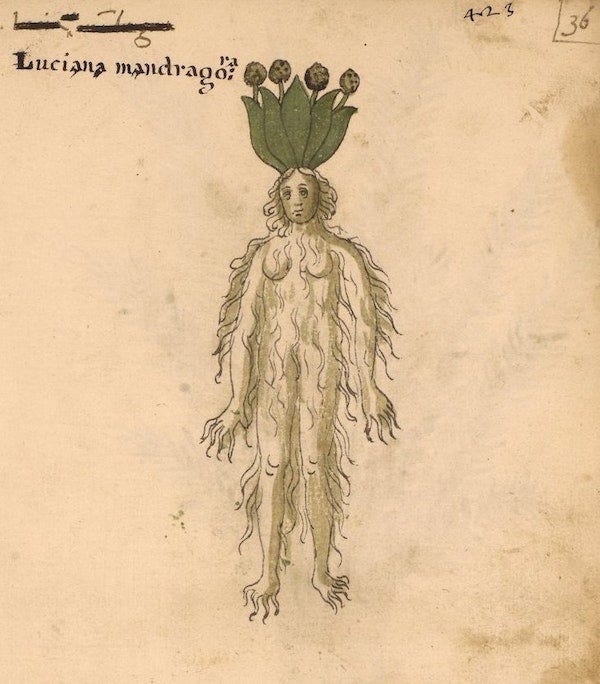
Dear Friends,
There are many ways to dream.
In the first year of my Zen meditation practice, I was frequently sleepy as I sat. Many times I had the experience of watching the wall in front of me transform from an ordinary surface into a phantasmagoria with curling vines and plants, parades of giraffes and elephants, tiny dramas and narratives playing out.
The visions seemed completely real until I blinked and woke myself a little to discover that the wall was once again a wall. This gave me a sense of the intimate proximity of the dream world — the dream-mind is always close at hand.
As we move through our ordinary waking days, dreams have the potential to erupt out of anything we encounter. Every object is a dream coalesced to matter and, at the same time, objects are the seeds of dreams waiting to happen.
Works of art, particularly, can be entered as if they were dreams. And of course there are dream-artists, artists whose work is made from visions and the stuff of the unconscious. One such is the Spanish-Mexican painter Remedios Varo who once said, “the dream world and the real world are the same.”
This week we take the visionary, dream-infused art and writing of Remedios Varo as our guide.
For those who have joined us recently, welcome! “Ways of Seeing” is a series of inspirations and practical exercises for deepening attention and engaging with art.
What happens when we see art and the world with the mind of dreaming?
— Sal
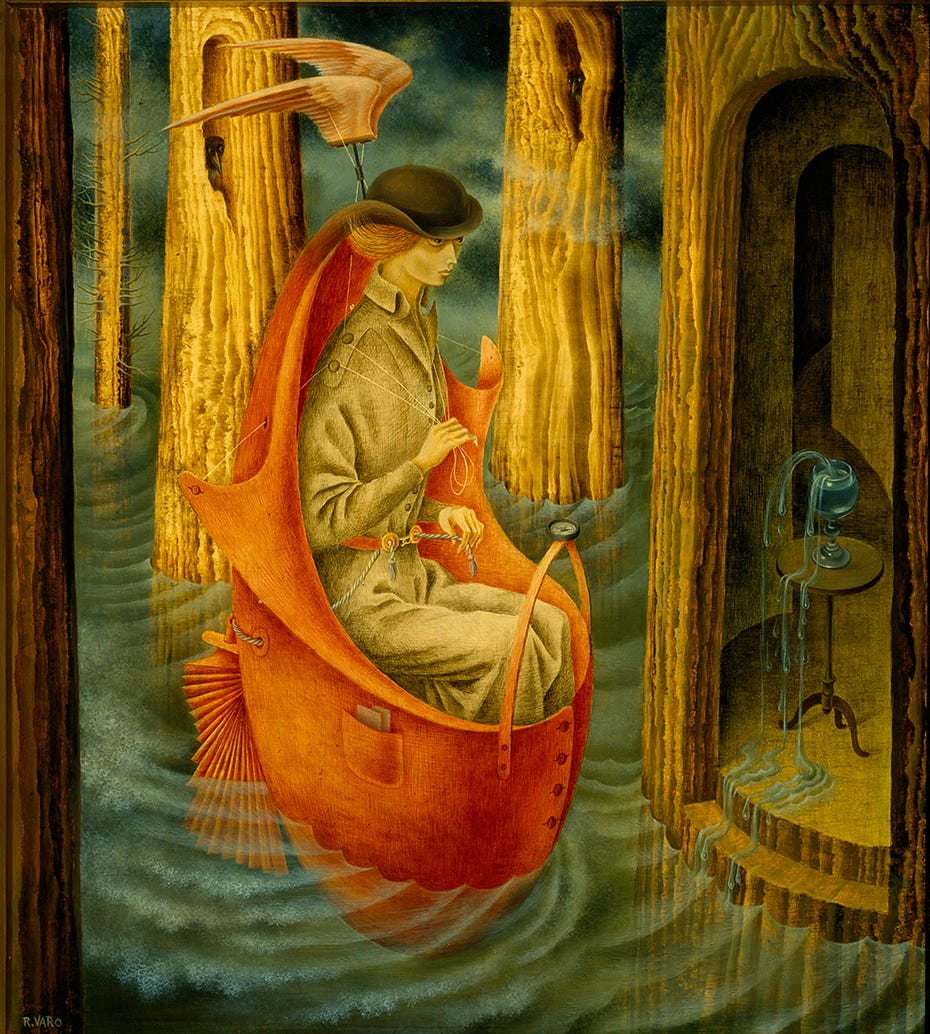
Remedios Varo
Remedios Varo was a visionary painter of mystical, dream-like images. She was born in Spain in 1908 and fled Europe for Mexico City after the Nazi occupation of Paris. She was close friends with Leonora Carrington and central to a circle of surrealist painters and writers.
Varo became celebrated as a painter during her lifetime, but she also wrote privately in playful and unusual forms. Her friend Leonora Carrington wrote a novel, The Hearing Trumpet, in which Varo appears as the character Carmella Velasquez. The striking thing about Carmelita is her practice of letter writing: “Carmella writes letters all over the world to people she has never met and signs them with all sorts of romantic names, never her own. […] These wonderful letters fly off, in a celestial way, by airmail, in Carmella’s delicate handwriting. No one ever replies.”
Varo’s ordinary household notebooks included these letters to strangers alongside her shopping lists, as well as dreams, automatic writing, descriptions of paintings, and a plan for a play. Varo’s notes and experiments were collected in a Mexican edition which has been translated by Margaret Carson as Letters, Dreams & Other Writings.
Let these excerpts from Varo’s writing remind you of your own dreams and visions.
Dreams and Visions
from Dream 3
I’m bathing an orange kitten in the sink of some hotel, but that’s not so, it seems instead that it’s Leonora, who’s wearing a large coat that needs to be washed. I spritz her with a little soapy water and keep on bathing the kitten, but am very puzzled and disturbed, because I’m not at all sure who it is I’m bathing. Somebody, one of the two, tells me that Mr. Gamboa has just left for Brussels and before leaving sent me a certified telegram, commanding me to paint the facade of his house turtledove gray. A moral anguish comes over me and at that moment someone knocks on the door. I go to open it and see a person wrapped in a dark cape and wearing a summery straw hat. He tells me he’s been sent by Mrs. Yellow. Of course! I understand at once that yellow as a decisive and conciliatory force bodes well for me.
from Dream 8
It was early in the morning and we were arranging the carpet in Leonora’s bedroom. It was a red carpet and had a very soft and silky pile, it was surely Oriental. We had decided that the best way to clean it and position it was by cutting it into slightly elongated rectangles, which we positioned one next to the other in a haphazard way. To us it seemed like playing dominoes and we decided we could use it every now and then for that.
from Dream 9
I was dreaming that I was asleep in my bedroom and a loud noise woke me up. The noise came from upstairs, from the studio, and it sounded as if a chair were being dragged. I thought it meant someone was trying to get in from the terrace and was pushing the chair that was against the door. I was frightened and it seemed prudent to let whoever it was know I was awake, but to do so without him realizing I knew he was there, so that he’d leave before something worse happened. I got up and from the door to my bedroom called upstairs to my cat, asking, “What’s all that commotion, Gordi?” I took another step forward and at that very moment, in utmost horror, I felt something behind me, or rather, something that was coming out of my own self. I realized at once that the alarming sound hadn’t come from upstairs; although I had wanted this threat to be outside and above, it was, in truth, always next to me or inside me.
Project 1
Wineglass forgotten on a table, barely any ruins by now; the desert (sand) invades everything. From the glass flows a miraculous water that keeps expanding into a stream.
Project 3
Within a grove in great disarray, a species of tree (the cell). Beside, a creature who is knitting with her own tresses a substance that lengthens and stretches out toward the horizon. A river separates this from the other side, where there’s a building with people, sages, et cetera, who observe this scene with a sort of microscope, telescope. On the river, a bridge, someone is crossing it in order to bring a kind of letter-homage to the knitter. Also the knitted fabric can be captured by someone who receives it in a purifying box (the box will be half musical instrument, and will represent harmony). Naturally, the fabric is being undone inside the box.
Description of Tailleur pour dames, 1957
This is the showroom of a ladies’ dressmaker. One design is for travel, very practical, shaped like a boat in back; when arriving at a stretch of water it plops down backwards; behind the head is a rudder, steered by pulling on the ribbons that drop to the chest and from which a compass hangs. All of it serves as an ornament, too, on dry land it rolls along and the lapels act as little sails, as does the walking stick, inside which. there’s a rolled-up sail that unfurls. The seated design is for going to those cocktail parties where not even a straight pin can fit and one doesn’t know where to put one’s glass, much less sit down; the shawl is woven from a miraculous substance that hardens at will and serves as a seat. The design on the right is for widows. It’s made of an effervescent fabric, like champagne; it has a little pocket for carrying a vial of poison. It ends in a very flattering reptilian tail. The tailor has a face drawn in the form of scissors; his shadow is so rebellious that it has to be fastened to the ceiling with a pin. The customer who is considering the design unfurls into two people, yet she she doesn’t know which of the three designs to choose, and her replicas, to either side and somewhat transparent, represent the state of doubt in which she finds herself.
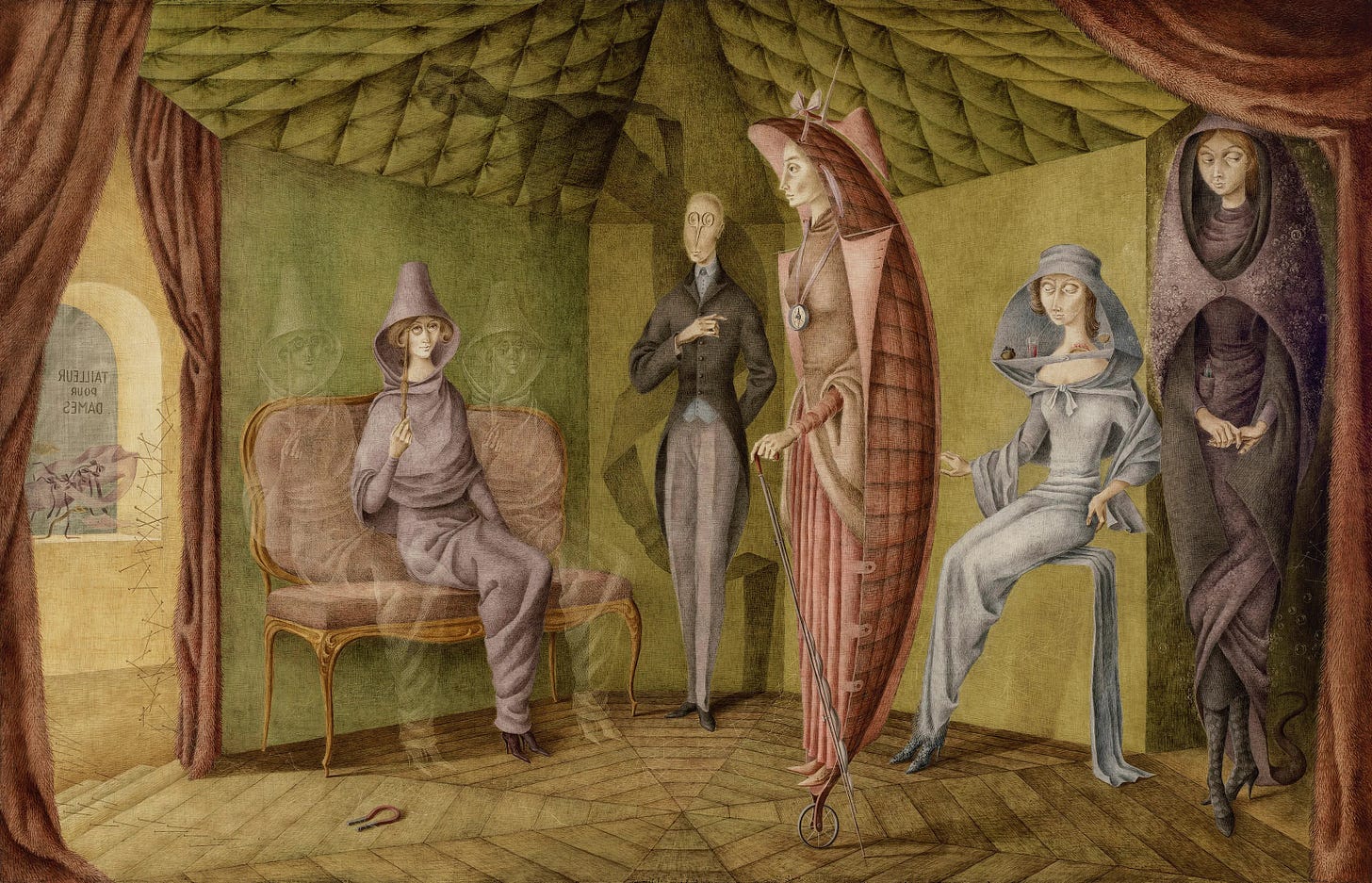
Exercise: Dream
Not all works of art are deliberately dreamlike, but we can still approach them with our dream-mind. The exercise below draws on experiences of the hypnagogic state — the mode of consciousness between waking and sleep when strange visions form of their own accord.
Are we dreaming the work, or is the work dreaming us?
As with all of these “Ways of Seeing,” the initiating impulse is to expand our possibilities for engaging with works of art and deepening attention. These exercises are perfect for time spent in museums, galleries, and studios. You can also bring them into the rest of your life and experiment with streets, libraries, parties, landscapes. Try them as writing or art-making prompts.
These practices work best if you give them some time, at least twenty minutes or a half-hour. This is easier to do if you set a timer.
As always, interpret these instructions freely and intuitively
Experience:
Begin by noticing one detail of the work. This could be a color, a form, an image, a texture — one small area. Perhaps a button, a finger, a stem, a patch of ochre, a glossy pink, a line that turns in on itself, a precise geometry. Zoom in. Let your dream begin right here.
Focus intently on whatever you have noticed until it begins to change of its own accord. Let it come to life. It is a character in a story that spins out from your noticing. Let your logics soften and grow new shapes. If you lose the thread, shift your attention slightly to a nearby detail and let a new story begin. Let the boundaries between the two become unpredictable. Let combinations become their own stories.Response:
Open your notebook, and before you are fully awake, write down your dream.
Share your results and reflections in the comments. I’d love to hear from you.
Remedios Varo
Sadly, Remedios Varo: Letters, Dreams & Other Writings (translated by Margaret Carson and published by Wakefield Press) is currently out of print. However, a number of excerpts from the book were published online, including:
“Letter to a Stranger” in Paris Review Daily
Four Dreams from “Remedios Varo: Letters, Dreams & Other Writings,” PEN America
“Homo Rodans” via the Art Institute of Chicago.
Plus this interview with translator Margaret Carson.
Other resources for exploring the work of Remedios Varo:
And if you are lucky enough to be in or near Chicago, the exhibition Remedios Varo: Science Fictions will be on view at the Art Institute of Chicago through November 27, 2023.
Remedios Varo: Science Fictions catalog from the Art Institute of Chicago.
The title Ways of Seeing is an homage to the continuing inspiration of the BBC TV series and book by John Berger.
Further adventures and new ways of seeing can be found in my book, The Uses of Art.
Artist Sal Randolph’s THE USES OF ART is a memoir of transformative encounters with works of art, inviting readers into new methods of looking that are both liberating and emboldening.
Dazzlingly original, ferociously intelligent.
— Michael Cunningham
A joyful, dazzling treasure-box of a book.
— Bonnie Friedman
Here’s a guide, to waking up, over and over again.
— Roshi Pat Enkyo O’Hara





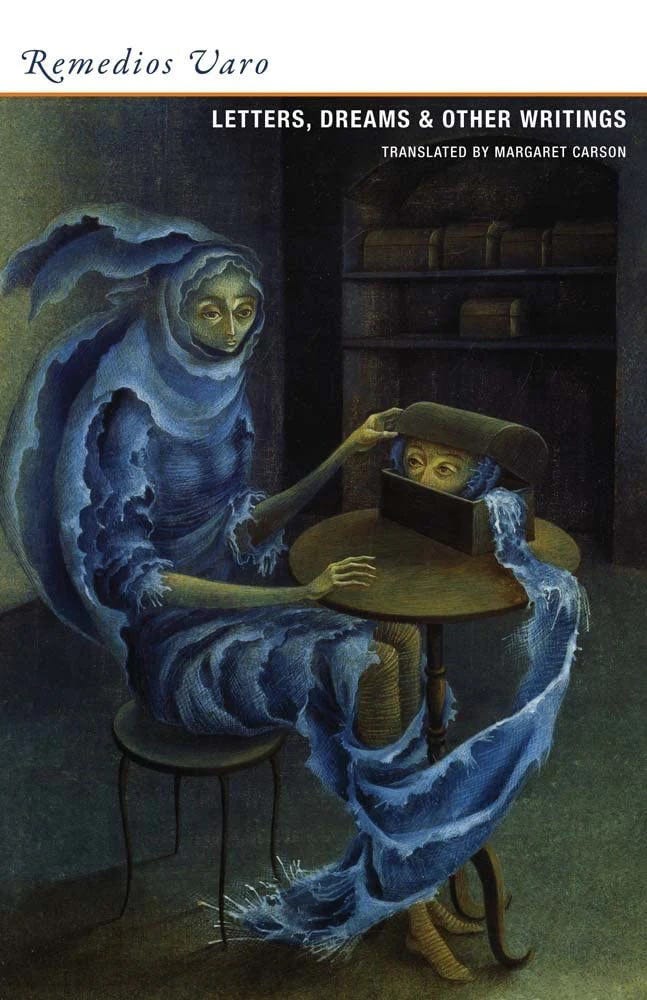

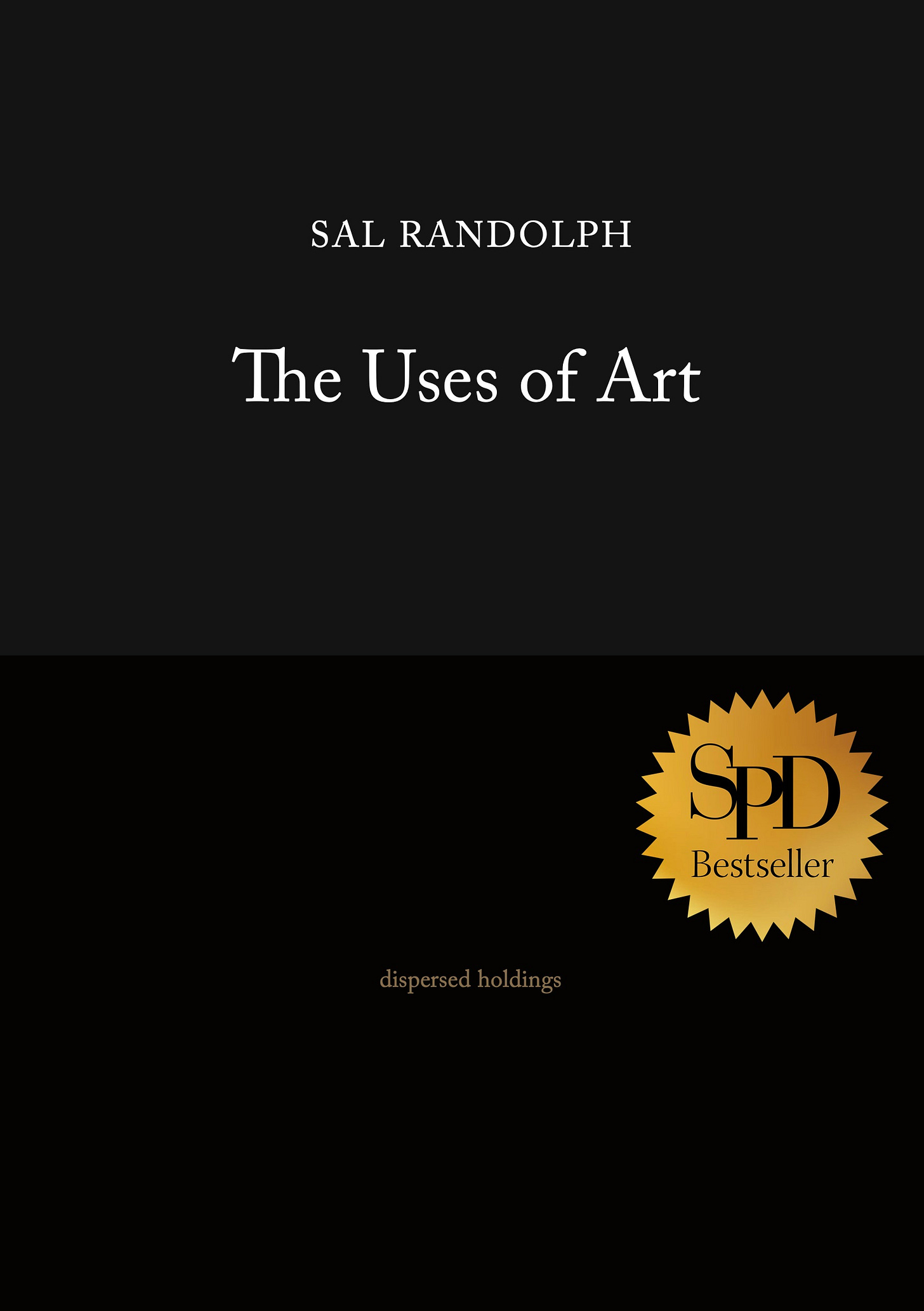
This is such a dreamy, inspiring piece and there are some great links to some of the material in that sadly out-of-print collection of Remedios Varo's writings. I see that the biography of Varo by Janet Kaplan is also close to impossible to get (over £200 on Amazon). It's time these women were better known, as I'm sure you'll agree, and this post can only help.
I love your account of staring at a wall and 'seeing things'! This, of course, is Da Vinci's recommendation in his Treatise on Painting and was taken up by the surrealists, especially Dali, who based his paranoic-critical method on it. I found a long and interesting article on Dali and seeing which might be of interest https://www.frontiersin.org/articles/10.3389/fnhum.2015.00496/full
As you can tell from my Fur Cup pieces here on Substack, I find that surrealist pictures almost can't help turning into moving, happening, dreams in front of my eyes and it'll be fun to use your specific instructions for my next journey into a surrealist world.
Varo's work is immediately enchanting and I love it with a passion! Thank you for all the extracts, too. What a treat!
I haven’t come across Varo’s work before and it’s really interesting! I love the richness of the imagery and imagination in her paintings.